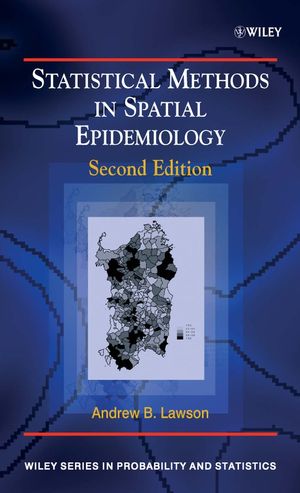Statistical Methods in Spatial Epidemiology, 2nd EditionISBN: 978-0-470-01484-4
Hardcover
424 pages
June 2006
 This is a Print-on-Demand title. It will be printed specifically to fill your order. Please allow an additional 10-15 days delivery time. The book is not returnable.
|
||||||
Preface and Acknowledgements.
I: The Nature of Spatial Epidemiology.
1. Definitions, Terminolgy and Data Sets.
1.1 Map Hypotheses and Modelling Approaches.
1.2 Definitions and Data Examples.
1.3 Further definitions.
1.4 Some Data Examples.
2.Scales of Measurement and Data Availability.
2.1 Small Scale.
2.2 Large Scale.
2.3 Rate Dependence.
2.4 DataQuality and the Ecological Fallacy.
2.5 Edge E.ects.
3.Geographical Representation and Mapping.
3.1 Introduction and Definitions.
3.2 Maps and Mapping.
3.3 Statistical Accuracy.
3.4 Aggregation.
3.5 Mapping Issues related toAggregated Data.
3.6 Conclusions.
4.Basic Models.
4.1 Sampling Considerations.
4.2 Likelihood-based and Bayesian Approaches.
4.3 Point EventModels.
4.4 CountModels.
5.Exploratory Approaches, Parametric Estimation and Inference.
5.1 ExploratoryMethods.
5.2 Parameter Estimation.
5.3 Residual Diagnostics.
5.4 Hypothesis Testing.
5.5 Edge E.ects.
II:Important Problems in Spatial Epidemiology.
6.Small Scale: Disease Clustering.
6.1 Definition of Clusters and Clustering.
6.2 Modelling Issues.
6.3 Hypothesis Tests for Clustering.
6.4 Space-Time Clustering.
6.5 Clustering Examples.
6.6 OtherMethods related to clustering.
7.Small Scale: Putative Sources of Hazard.
7.1 Introduction.
7.2 StudyDesign.
7.3 Problems of Inference.
7.4 Modelling the Hazard Exposure Risk.
7.5 Models for Case Event Data.
7.6 ACase Event Example.
7.7 Models for CountData.
7.8 ACountData Example.
7.9 OtherDirections.
8. Large Scale: Disease Mapping.
8.1 Introduction.
8.2 Simple Statistical Representation.
8.3 BasicModels.
8.4 AdvancedMethods.
8.5 Model Variants and Extensions.
8.6 ApproximateMethods.
8.7 MultivariateMethods.
8.8 Evaluation ofModel Performance.
8.9 Hypothesis Testing in DiseaseMapping.
8.10 Space-Time DiseaseMapping.
8.11 Spatial Survival and longitudinal data.
8.12 DiseaseMapping: Case Studies.
9.Ecological Analysis and Scale Change.
9.1 Ecological Analysis: Introduction.
9.2 Small-ScaleModelling Issues.
9.3 Changes of Scale andMAUP.
9.4 A Simple Example: Sudden Infant Death in North Carolina.
9.5 ACase Study: Malaria and IDDM.
10.Infectious Disease Modelling.
10.1 Introduction.
10.2 GeneralModelDevelopment.
10.3 SpatialModelDevelopment.
10.4 Modelling Special Cases for Individual Level Data.
10.5 Survival Analysis with spatial dependence.
10.6 Individual level data example.
10.7 Underascertainment and Censoring.
10.8 Conclusions.
11.Large Scale: Surveillance.
11.1 Process ControlMethodology.
11.2 Spatio-Temporal Modelling.
11.3 Spatio-TemporalMonitoring.
11.4 Syndromic Surveillance.
11.5 Multivariate-Mulitfocus Surveillance.
11.6 Bayesian Approaches.
11.7 Computational Considerations.
11.8 Infectious Diseases.
11.9 Conclusions.
Appendix A:Monte Carlo Testing, Parametric Bootstrap and Simulation Envelopes.
Appendix B:Markov ChainMonte Carlo Methods.
Appendix C:Algorithms and Software.
Appendix D: Glossary of Estimators.
Appendix E:Software.
Bibliography.
Index.



